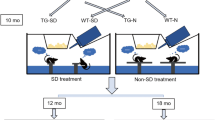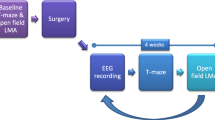Abstract
Disruption of the sleep-wake cycle has been reported among individuals with Down syndrome (DS). Here we studied behavioral rhythms in adult male and female Ts65Dn mice, a model of DS. The overall behavioral activity of Ts65Dn and diploid (2N) littermates as defined by total movements (TM), movement time (MT), ambulatory movement time (AMT), time spent in center of arena (CT), jumps (JFP), rotational behavior (TURNS), and wheel-running activity (WRA) was recorded under a 12 h:12 h light–dark photocycle. During the light phase, Ts65Dn mice exhibited higher TM, MT, CT, JFP, and WRA compared to 2N littermates. During the dark phase, Ts65Dn and 2N mice differed only in CT and WRA, with the Ts65Dn group engaging in higher levels of both. There were no gender differences for any of the behavioral variables studied. Non-linear least-squares (Cosinor) analysis of the distribution of total behavioral activity (TM) indicated that Ts65Dn mice exhibited a slightly higher mean oscillation (i.e., mesor), but significantly lower amplitude in comparison to 2N mice, suggesting that levels of TM were elevated in trisomic mice but were relatively constant throughout the photocycle. The peak of the Ts65Dn TM rhythm was significantly phase-advanced, occurring approximately 4 h earlier than 2N mice. Overall, Ts65Dn mice were hyperactive and differed significantly in daily patterns of specific behaviors from those of 2N littermates. To control for the potential confound of retinal degeneration in Ts65Dn and 2N mice, we compared and found no difference between the TM rhythm parameters of 2N and non-retinally degenerate C57/129Sv mice, suggesting that abnormal behavioral rhythmicity in Ts65Dn mice may not due to the absence of rod and cone photoreceptors. These results serve as a starting point for further investigations into the physiological basis of sleep–wake disturbances in DS patients.



Similar content being viewed by others
References
Ambree O, Touma C, Gortz N, Keyvani K, Paulus W, Palme R, Sachser N (2006) Acitivty changes and marked stereotypic behavior precede Aβ pathology in TgCRND8 Alzheimer mice. Neurobiol. Aging 27:955–964
Belichenko PV, Masliah E, Kleschevnikov AM, Villar AJ, Epstein CJ, Salehi A, Mobley WC (2004) Synaptic structural abnormalities in the Ts65Dn mouse model of Down Syndrome. J Comp Neurol 480:281–298
Benavides-Piccione R, Ballesteros-Yanez I, de Lagran MM, Elston G, Estivill X, Fillat C, Defelipe J, Dierssen M (2004) On dendrites in Down syndrome and DS murine models: a spiny way to learn. Prog Neurobiol 74:111–126
Bimonte-Nelson HA, Hunter CL, Nelson ME, Granholm AC (2003) Frontal cortex BDNF levels correlate with working memory in an animal model of Down syndrome. Behav Brain Res 139:7–57
Chang B, Hawes NL, Hurd RE, Davisson, MT, Nusinowitz S, Heckenlively JR (2002) Retinal degeneration mutants in the mouse. Vision Res 42:517–525
Cooper SA, Prasher VP (1998) Maladaptive behaviours and symptoms of dementia in adults with Down syndrome compared with adults with intellectual disability of other etiologies. J Intellect Disabil Res 42:293–300
Cotton S, Richdale A (2006) Parental descriptions of sleep problems in children with autism, Down syndrome, and Prader–Willi syndrome. Res Dev Disabil 27:151–161
Coussons-Read ME, Crnic LS (1996) Behavioral assessment of the Ts65Dn mouse, a model for Down syndrome: altered behavior in the elevated plus maze and open field. Behav Genet 26:7–13
Costa AC, Walsh K, Davisson MT (1999) Motor dysfunction in a mouse model for Down syndrome. Physiol Behav 68:211–220
Dahlqvist A, Rask E, Rosenqvist CJ, Sahlin C, Franklin KA (2003) Sleep apnea and Down syndrome. Acta Otolaryngol 123:1094–1097
Davisson MT, Schmidt C, Akeson EC (1990) Segmental trisomy of murine chromosome 16: a new system for studying Down syndrome. In: Patteron D, Epstein CJ (eds) Molecular genetics of chromosome 21 and Down syndrome. Wiley-Liss, New York, pp. 263–280
Demas GE, Nelson RJ, Krueger BK, Yarowsky PJ (1996) Spatial memory deficits in segmental trisomic Ts65Dn mice. Behav Brain Res 2:5–92
Driscoll LL, Carroll JC, Moon J, Crnic LS, Levitsky DA, Strupp BJ (2004) Impaired sustained attention and error-induced stereotypy in the aged Ts65Dn mouse: a model of Down syndrome and Alzheimer’s disease. Behav Neurosci 118:1196–1205
Easton A, Meerlo P, Bergmann B, Turek FW (2004) The suprachiasmatic nucleus regulates sleep timing and amount in mice. Sleep 27:1307–1318
Escorihuela RM, Fernandez-Teruel A, Vallina IF, Baamonde C, Lumbreras MA, Dierssen M, Tobena A, Florez J (1995) A behavioral assessment of Ts65Dn mice: a putative Down syndrome model. Neurosci Lett 199:43–146
Escorihuela RM, Vallina IF, Martinez-Cue C, Baamonde C, Dierssen M, Tobena A, Florez J, Fernandez-Teruel A (1998) Impaired short-and long-term memory in Ts65Dn mice, a model for Down syndrome. Neurosci Lett 247:171–174
Ferguson SA, Kenneway DJ, Moyer RW (1999) Nicotine phase shifts the 6-sulphatoxymelatonin rhythm and induces c-Fos in the SCN of rats. Brain Res Bull 48:527–538
Finkel SI (2003) Behavioral and psychological symptoms of dementia. Clin. Geriatr Med 19:799–824
Hampton TG, Stasko MR, Kale A, Amende I, Costa AC (2004) Gait dynamics in trisomic mice: quantitative neurological traits of Down syndrome. Physiol Behav 82:381–389
Hastings M, Maywood ES (2000) Circadian clocks in the mammalian brain. BioEssays 22:23–31
Holtzman DM, Santucci D, Killbridge J, Chua-Couzens J, Fontana DJ, Daniels SE, Johnson RM, Chen K, Sun Y, Carlson E, Alleva E, Epstein CJ, Mobley WC (1996) Developmental abnormalities and age-related neurodegeneration in a mouse model of Down syndrome. Proc Natl Acad Sci USA 93:13333–13338
Hsiao K, Chapman P, Nilsen S, Eckman C, Harigaya Y, Younkin S, Yang F, Cole G (1996) Correlative memory deficits, A-beta elevation, and amyloid plaques in transgenic mice. Science 274:99–102
Hunter CL, Isacson O, Nelson M, Bimonte-Nelson H, Seo H, Lin L, Ford K, Kindy MS, Granholm A-C (2003) Regional alterations in amyloid precursor protein and nerve growth factor across age in a mouse model of Down’s syndrome. Neurosci Res 45:437–445
Klein SL, Kriegsfeld LJ, Hairston JE, Rau V, Nelson RJ, Yarowsky PJ (1996) Characterization of sensorimotor performance, reproductive and aggressive behaviors in segmental trisomic 16 (Ts65Dn) mice. Physiol Behav 60:1159–1164
Krout KE, Kawano J, Mettenleiter TC, Loewy AD (2002) CNS inputs to the suprachiasmatic nucleus of the rat. Neuroscience 110:73–92
Lalonde R, Dumont M, Staufenbiel M, Sturchler-Pierrat C, Strazielle C (2002) Spatial learning, exploration, anxiety, motor coordination in female APP23 transgenic mice with the Swedish mutation. Brain Res 956:36–44
Levanon A, Tarasiuk A, Tal A (1999) Sleep characteristics in children with Down syndrome. J Pediatr 134:755–760
Low-Zeddies SS, Takahashi JS (2001) Chimera analysis of the Clock mutation in mice shows that complex cellular integration determines circadian behavior. Cell 105:25–42
Liu DP, Schnidt C, Billings T, Davisson MT (2003) Quantitative PCR genotyping assay for the Ts65Dn mouse model of Down syndrome. Biotechniques 35:1–7
Marashi V, Barnekow A, Ossendorf E, Sachser N (2003) Effects of different forms of environmental enrichment on behavioral, endocrinological, and immunological parameters in male mice. Horm Behav 43:281–292
Martinez-Cue C, Baamonde C, Lumbreras M, Paz J, Davisson MT, Schmidt C, Diersson M, Florez J (2002) Differential effects of environmental enrichment on behavior and learning of male and female Ts65Dn mice, a model for Down syndrome. Behav Brain Res 134:185–200
Moore RY (1996) Entrainment pathways and the functional organization of the circadian system. Prog Brain Res 111:103–119
Mrak RE, Griffin WS (2004) Trisomy 21 and the brain. J Neuropathol Exp Neurol 63:679–85
Mrosovsky N (2003) Contribution of classic photoreceptors to entrainment. J Comp Physiol A 189:69–73
Mrosovsky N (2003) Aschoff’s rule in retinally degenerate mice. J Comp Physiol A 189:75–78
Niedermayer E (2001) Frontal lobe disinhibition, Rett syndrome and attention deficit hyperactivity disorder. Clin Electroencephalogr 32:20–23
Nelson DL, Gibbs RA (2004) The critical region in Trisomy 21. Science 306:619–621
Pitovcakova J, Makatsori A, Sulcova A, Jezova D (2005) Felbamate reduces hormone release and locomotor hypoactivity induced by repeated stress of social defeat in mice. Eur Neuropsychopharmacol 15:153–158
Provencio I, Wong S, Lederman AB, Argamaso SM, Foster RG (1994) Visual and circadian responses to light in aged retinally degenerate mice. Vision Res 34:1799–1806
Provencio I, Cooper HM, Foster RG (1998) Retinal projections in mice with inherited retinal degeneration: implications for circadian photoentrainment. J Comp Neurol 395:417–439
Ralph MR, Foster RG, Davis FC, Menaker M (1990) Transplanted suprachiasmatic nucleus determines circadian period. Science 247:975–978
Richtsmeier JT, Zumwalt A, Carlson EJ, Epstein CJ, Reeves RH (2002) Craniofacial phenotypes in segmentally trisomic mouse models for Down syndrome. Am J Med Genet 107:317–324
Sancar A (2000) Cryptochrome: the second photoactive pigment in the eye and its role in circadian photoreception. Annu Rev Biochem 69:31–67
Selby CP, Thompson C, Schmitz TM, van Gelder RN, Sancar A (2000) Functional redundancy of cryptochromes and classical photoreceptors for nonvisual ocular photoreception in mice. Proc Natl Acad Sci USA 97:14697–14702
Seo H, Isacson O (2005) Abnormal APP, cholinergic and cognitive function in Ts65Dn Down’s model mice. Exp Neurol 193:469–480
Stewart LS, Potok A, Camper SA, Stifani S (2005) Runx1 expression defines a subpopulation of displaced amacrine cells in the developing mouse retina. J Neurochem 94:1739–1745
Tate B, Aboody-Guterman KS, Morris AM, Walcott EC, Majocha RE, Marotta CA (1992) Disruption of circadian regulation by brain grafts that overexpress Alzheimer beta/A4 amyloid. Proc Natl Acad Sci USA 89:7090–7094
Teipel SJ, Hampel H (2006) Neuroanatomy of Down syndrome in vivo: a model of preclinical Alzheimer’s disease. Behav Genet 36:405–415
Teicher MH, Barber NI (1990) COSIFIT: an interactive program for simultaneous multioscillator Cosinor analysis of time-series data. Comp Biomed Res 23:283–295
Tsiouris JA, Brown WT (2004) Neuropyschiatric symptoms of fragile X syndrome: pathophysiology and pharmacotherapy. CNS Drugs 18:687–703
Turek FW (1985) Circadian neural rhythms in mammals. Ann Rev Physiol 47:49–64
Turner CA, Presti MF, Newman HA, Bugenhagen P, Crnic L, Lewis MH (2001) Spontaneous stereotypy in an animal model of Down syndrome: Ts65Dn mice. Behav Genet 31:393–400
Vicari S (2006) Motor development and neuropsychological patterns in persons with Down syndrome. Behav Genet 36:355–364
Vitiello MV, Prinz PN (1989) Alzheimer’s disease. Sleep and sleep/wake patterns. Clin Geriatr Med 5:289–299
Wilsor JP, Edgar DM, Yesavage J, Ryan HS, McCormick CM, Lapustea N, Murphy GM (2005) Sleep and circadian abnormalities in a transgenic mouse model of Alzheimer’s disease: a role for cholinergic transmission. Neuroscience 131:375–385
Acknowledgments
The authors thank Dr. Zhengpheng Jia, Zarko Todorovski, Ilyas Aleem, and the Laboratory Animal Services at the Hospital for Sick Children for assistance. We also thank Dr. Lily Shen for the breeding and genotyping of the Ts65Dn mouse line. This work was supported by grants from The Hospital for Sick Children Down Syndrome Fund (#3217656151) to M.A.C. and The Canadian Institutes of Health Research (#3210016078) to O.C.S., III. L.S.S. is the recipient of a postdoctoral fellowship (#PDF-313950-2005) from the Natural Sciences and Engineering Research Council of Canada.
Author information
Authors and Affiliations
Corresponding author
Additional information
Edited by Pierre Roubertoux
Rights and permissions
About this article
Cite this article
Stewart, L.S., Persinger, M.A., Cortez, M.A. et al. Chronobiometry of Behavioral Activity in the Ts65Dn Model of Down Syndrome. Behav Genet 37, 388–398 (2007). https://doi.org/10.1007/s10519-006-9119-y
Received:
Accepted:
Published:
Issue Date:
DOI: https://doi.org/10.1007/s10519-006-9119-y




